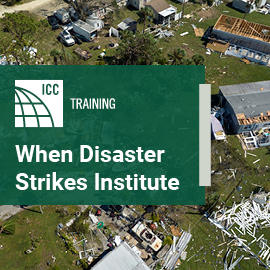
When Disaster Strikes Institute: Preparing Building Safety Professionals for the Aftermath of a Disaster
This program offers valuable instruction, hands-on activities and case studies, all designed to prepare building safety professionals to plan for, respond to and evaluate damage to our built environment after a disaster.
The safety and well-being of our communities depend on preparedness, response and an organized recovery effort. The International Code Council’s When Disaster Strikes (WDS) Institute provides essential training for those who play a key role in evaluating the safety of structures and helping ensure the safety of occupants in the aftermath of a disaster.
This program offers valuable instruction, hands-on activities and case studies, all designed to prepare building safety professionals to plan for, respond to and evaluate damage to our built environment after a disaster.
First-Hand Experience with the WDS Institute
Don Buckley, Fire Marshal for the Draper City Fire Department in Utah, is a strong advocate for the WDS Institute and its importance for communities across the country. A seasoned expert in fire codes with over 20 years of experience, Buckley has seen firsthand the importance of being prepared for disasters.
His journey into the world of disaster preparedness began in North Wildwood, New Jersey, where he started his career in the fire service in 1993. After moving to Utah in 1995, Buckley became further involved in fire prevention and code enforcement, working as a Fire Inspector and later serving as the Area Fire Marshal for Draper City.
As someone who has worked extensively with emergency management and fire codes, Buckley saw the WDS program as an opportunity to improve disaster preparedness for Utah’s fire marshals, building officials and emergency managers.
“I came across WDS when looking for a class that would benefit our Fire Marshals Association, our building officials, as well as emergency managers,” Buckley explains. “Even though Utah doesn’t have hurricanes like I experienced growing up in New Jersey, we face risks like flooding and earthquakes. The training offered by WDS teaches us how to evaluate a structure before, during and after a disaster.”
Buckley’s role in the WDS Institute is to ensure that the program runs smoothly for all participants, from registration to overseeing the interaction between attendees and instructors. For each session, Buckley works closely with William Bracken, a knowledgeable and experienced instructor for the Institute. According to Buckley, many attendees walk away from the Institute with a renewed sense of the importance of disaster preparedness.
“One attendee told me they thought they were prepared for a major disaster, but after completing the course, they realized there was a lot more they could be doing to be ready,” Buckley shared. The interactive nature of the program helps participants recognize potential gaps in their preparedness and offers solutions to address them.
The Importance of Staying Prepared
The WDS Institute is not only an opportunity to increase knowledge but also a chance for participants to maintain their credentials as Post-Disaster Building Safety Evaluators. This is critical for professionals in the field who need to stay up-to-date on the latest best practices and policies. It’s a program that blends practical instruction with real-world relevance, ensuring participants are well-equipped to respond to disasters of any kind.
If you are interested in disaster preparedness, building safety or emergency management, getting involved in the WDS Institute is a meaningful way to contribute to the safety of your community.
“Even if you have been a first responder on a disaster take this course. I say this because you will have your eyes opened even more when you learn how to better evaluate a structure after the disaster. This course uses real life examples to help you better understand why this is an important piece of the National Incident Management System,” shared Buckley.
Buckley encourages others in his field to consider taking part in the Institute. “The more we can educate ourselves on the steps needed to properly assess a structure after a disaster, the better prepared we’ll be to help our communities. The WDS Institute is a vital resource, and I’m proud to help make this training available to our state’s emergency responders and safety professionals.”
To learn more about the Code Council’s When Disaster Strikes Institute, click here.








